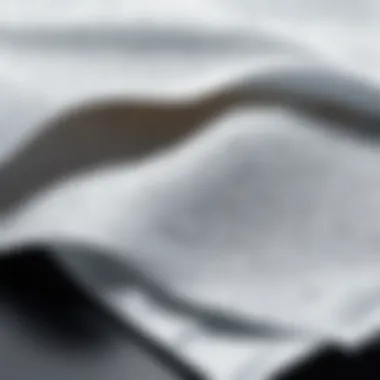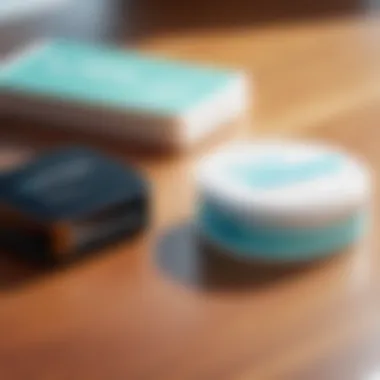Understanding Lens Cleaner Wipes: Applications & Effectiveness


Intro
Cleaning various screens and lenses is an important task that many of us often overlook. The clarity of these devices directly affects our experience, whether we are watching a video, gaming, or simply using a smartphone. This is where lens cleaner wipes come in. They have become popular due to their convenience and effectiveness in maintaining cleanliness.
However, not all wipes are created equal. There are differences in composition, performance, and application depending on the type of device you are cleaning. Understanding these variances can greatly enhance your cleaning routine and protect your devices.
In this article, we will delve into the specifications, effectiveness, and various applications of lens cleaner wipes. We will also discuss the latest trends and offer guidance on selecting the most suitable products for your needs. Let us start with the technical specifications of lens cleaner wipes.
Technical Specifications
Detailed Product Specs
Lens cleaner wipes come in various forms, including pre-moistened wipes, spray solutions, and homemade alternatives. The wipes are typically composed of non-woven material imbued with a cleaning solution. This solution often includes a mix of distilled water, isopropyl alcohol, and a surfactant.
- Material: Non-woven fabric
- Cleaning Solution Composition:
- Distilled water
- Isopropyl alcohol
- Surfactant (varies by brand)
Performance Metrics
The effectiveness of lens cleaner wipes can be measured through different performance metrics:
- Cleaning Efficacy: Ability to remove dirt, smudges, and streaks.
- Drying Time: Time taken for the surface to dry after cleaning.
- Surface Safety: Compatibility with various screen and lens materials (e.g., glass, plastic).
Compatibility Information
It is crucial to know that some cleaning solutions may react negatively with certain surfaces. For instance, wipes intended for glasses might not be safe for use on electronic screens due to different coatings and materials. Always check the label for compatibility with your specific device.
Practical Applications
Use Cases for Different Users
The applications of lens cleaner wipes range across various user demographics:
- Gamers: Keep screens free of fingerprints for an optimal visual experience.
- PC Builders: Ensure components are clean without leaving residues.
- Everyday Users: Maintain cleanliness on smartphones, tablets, and laptops.
Recommended Configurations
It is advisable to maintain a few configurations based on your device:
- For Screen Cleaning: Use wipes designed specifically for LCD or OLED screens.
- For Glass Lenses: Opt for wipes that contain anti-fog or anti-static properties.
Multi-Platform Performances
Some products are versatile enough to work across multiple platforms, such as:
- Smartphones and Tablets: These generally can use the same wipes.
- Glasses and VR Headsets: Ensure the formulation does not damage sensitive coatings.
“The right lens cleaner wipe can save you both time and money by prolonging the lifespan of your devices.”
Latest Trends
Industry Developments
The industry is seeing an increase in eco-friendly wipes made from biodegradable materials. This shift is valuable for environmentally-conscious consumers.
Emerging Technologies
Some manufacturers are integrating antimicrobial agents in their wipes to prevent bacteria build-up on surfaces. This is especially relevant for frequently touched devices.
Future Predictions
As technology progresses, we can expect more specialized wipes that cater to high-end devices, promising improved cleaning efficacy and safety.


Buying Guides
Recommended Products
Opt for reputable brands known for their reliability, such as Zeiss and Eco-Wipes. These brands offer a range of effective solutions tailored for specific needs.
Purchasing Tips
When buying lens cleaner wipes, consider the following:
- Read reviews to assess effectiveness.
- Check for any mention of surface compatibility.
Warranty and Support Information
Selecting products with good customer support can be beneficial. Verify if the brand offers a satisfaction guarantee or return policy.
By understanding these facets of lens cleaner wipes, you can ensure the best care for your electronic and optical devices.
Foreword to Lens Cleaner Wipes
The role of lens cleaner wipes cannot be overstated. For anyone using electronic devices or optical tools, maintaining clarity is not just a matter of aesthetics. It influences performance and prolongs the lifespan of these items. Various surfaces, including lenses of eyeglasses, camera lenses, and screens of devices, encounter fingerprints, dust, and smudges on a daily basis.
Lens cleaner wipes offer a convenient solution to tackle these common issues. They are designed with specific formulations that cater to delicate surfaces, ensuring there is no damage while effectively removing contaminants. This importance extends beyond merely achieving a spotless look; it can enhance visibility, improve device efficiency, and maintain the quality of optical devices.
The composition of these wipes is critical. With a clear understanding of what goes into them, users can make informed decisions about their cleaning routine. Knowing the potential consequences of using improper cleaning methods or solutions can save individuals from costly damages.
For the tech-savvy consumer and everyday users alike, grasping the applications and effectiveness of lens cleaner wipes can lead to better practices. This article will delve into specific uses, item composition, and efficacy, providing a comprehensive guide that emphasizes the need for suitable care of valuable assets. The next sections will discuss various applications of these wipes and explore their effectiveness concerning alternative cleaning solutions.
The right cleaning method is essential not only for appearance but also for the longevity of your devices.
Composition of Lens Cleaner Wipes
Understanding the composition of lens cleaner wipes is crucial in determining their effectiveness and suitability for specific cleaning tasks. The ingredients and materials involved directly influence how well these wipes can remove dirt, smudges, and other residues without causing harm to sensitive surfaces. When selecting lens cleaner wipes, knowing what they contain helps ensure user safety and the longevity of the items being cleaned.
Common Ingredients in Lens Cleaning Solutions
Lens cleaning wipes typically contain a mix of cleaning agents, solvents, and surfactants. Here are some common components found in these solutions:
- Distilled Water: This acts as the primary solvent, ensuring that the wipes are not too harsh and can safely clean a variety of surfaces.
- Isopropyl Alcohol: Known for its quick evaporation and strong cleaning properties, isopropyl alcohol helps dissolve oils and grime.
- Surfactants: These play a key role in breaking down dirt and debris, making it easier to wipe away. Common surfactants include non-ionic and anionic varieties.
- Fragrance: Some products may include fragrance to enhance the user experience, though this ingredient is optional and may not be necessary for functionality.
- Preservatives: These may be included to prolong the shelf life of the wipes and to prevent microbial growth in the cleaning solution.
Choosing a lens cleaner wipe with the right balance of these ingredients can enhance cleaning efficiency while reducing potential risks for sensitive surfaces. Some users may prioritize wipes with fewer chemicals to minimize exposure.
Material of the Wipes
The material used for the wipes themselves is just as important as the cleaning solution. The best lens cleaner wipes are often made from soft, lint-free fabrics that are gentle on surfaces. Common materials include:
- Microfiber: This is the most favored material. Microfiber is effective in trapping dirt and oil without leaving scratches or lint behind. This feature makes it ideal for cleaning glasses and screens.
- Polyester: Sometimes used in combination with other materials, polyester is durable and can be made into low-linting wipes.
- Cellulose: Some wipes are made of cellulose, a biodegradable material that is soft and absorbent but may not perform as well as microfiber in terms of trapping dirt.
When selecting a lens cleaner wipe, consider both the cleaning solution and wipe material for a comprehensive cleaning experience. The ideal combination results in optimal cleaning without risking damage to delicate surfaces.
It is always advisable to test a small area before using lens cleaner wipes on valuable equipment or surfaces, especially if you are not sure about compatibility.
Applications of Lens Cleaner Wipes
Lens cleaner wipes serve multiple purposes, which makes them versatile in daily usage. They are indispensable tools for maintaining clarity in vision and performance of various electronic devices. Understanding the specific applications of lens cleaner wipes is crucial for ensuring both effectiveness and longevity of your everyday items. The benefits of using these wipes include convenience, efficiency in cleaning, and the ability to reduce the risk of damage to delicate surfaces.
Cleaning Eyeglasses
Eyeglasses often accumulate smudges and dirt that can impair vision. Lens cleaner wipes are specifically designed to address this issue. They offer a gentle yet effective solution for cleaning lenses without scratching or damaging coatings. The formula in these wipes often includes specific cleaning agents that break down smudges and oils, enhancing the visual clarity significantly.
Using wipes ensures a streak-free finish, which is crucial for maintaining optimal vision. Furthermore, they are portable and can be used conveniently throughout the day, especially when you notice your glasses getting dirty. It is important to choose wipes that are alcohol-free to prevent any deterioration of lens coatings.
Wiping Down Electronics


In today’s digital era, devices like smartphones, tablets, and laptops are part of daily life. These screens attract fingerprints and dust, impacting visibility. Lens cleaner wipes provide a safe option for cleaning these surfaces. Their composition often includes non-abrasive materials, which minimizes the risk of scratching.
Regularly cleaning electronic devices with these wipes helps maintain touchscreen sensitivity and visibility. The convenience of having pre-moistened wipes allows quick clean-ups without the need for liquid cleaners, which can be cumbersome. By using lens cleaner wipes, users can avoid streaks and residue that might otherwise obscure screen clarity.
Utilizing for Camera Lenses
Camera lenses require special care to maintain their optical quality. Dust, smudges, and fingerprints can hinder image clarity. For photographers, keeping the lens clean is an essential part of equipment maintenance. Lens cleaner wipes designed specifically for camera lenses come with ingredients that effectively lift dirt without harming the delicate surface.
Using these wipes can prevent scratches that are often caused by cleaning with improperly chosen materials. It is advisable to use wipes that are specifically labeled safe for use on optical glass. This practice enhances image quality and ensures that the equipment remains in good condition, prolonging its lifespan.
Effectiveness of Lens Cleaner Wipes
The effectiveness of lens cleaner wipes is a crucial factor in maintaining the clarity and functionality of various optical and electronic devices. With the increasing reliance on screens, whether for work or leisure, the demand for effective cleaning solutions is higher than ever. Lens cleaner wipes offer a convenient option to ensure that devices remain free from dust, smudges, and fingerprints, thus enhancing the user experience. It is essential to comprehend not only the benefits of using these wipes, but also considerations related to their effectiveness.
Comparison with Other Cleaning Methods
When evaluating the effectiveness of lens cleaner wipes, it is helpful to compare them to other cleaning methods. Traditional cloths, spray cleaners, and homemade solutions each have their merits, but also limitations.
- Lens cleaner wipes are designed for quick cleaning without the need for additional tools.
- Traditional cloths often require a separate cleaner, which can lead to improper application and the use of inappropriate substances.
- Spray cleaners may offer a more customizable cleaning experience but can sometimes leave excess moisture on surfaces.
- Homemade solutions can be economical but may not be equipped with the right ingredients for safe cleaning of delicate surfaces.
In many cases, lens cleaner wipes offer a balanced approach, combining convenience and effectiveness. Users can confidently reach for a wipe, knowing it is specially formulated to clean lenses and screens without causing damage.
Understanding Streak-Free Cleaning
Streak-free cleaning is a hallmark of quality lens cleaner wipes. Many people find it frustrating to clean screens, only to discover that streaks remain. It is important to understand why this occurs and how lens cleaner wipes effectively address the issue.
When using lens cleaner wipes, the formulation allows for a quick evaporation of moisture, preventing streak formation. The right balance of solvent and surfactants helps to dissolve oils and dirt without leaving a residue. It is worth noting that using an overly saturated wipe can still lead to streaks, but most commercially available products are specifically engineered for streak-free performance.
“Choosing a high-quality lens cleaner wipe is essential for achieving the best cleaning results.”
Users should follow the manufacturer's instructions and use an appropriate amount of pressure. A gentle circular motion often yields the best results, ensuring that all areas are thoroughly cleaned while reducing the chances of streaks.
In summary, the effectiveness of lens cleaner wipes lies in their unique formulation and application method, making them a preferred choice for tech-savvy consumers. By understanding their advantages over other cleaning methods and the importance of streak-free cleaning, users can maintain their devices in optimal condition.
Safety Considerations in Cleaning
When using lens cleaner wipes, understanding safety is paramount. Different materials and coatings on lenses or screens can react unpredictably to chemicals found in cleaning solutions. Overlooking this can lead to irreversible damage, rendering expensive equipment unusable. Therefore, careful selection and use of wipes are key to preserving the integrity of sensitive surfaces.
Material Compatibility
Material compatibility refers to how cleaning products interact with different surfaces. Many electronic devices and optical lenses have specialized coatings. These may include anti-reflective or anti-scratch layers. Always check if the cleaner is safe for these specific materials. For instance, alcohol-based wipes can damage some coatings. Therefore, the best practice is to choose wipes clearly labeled as safe for the surface you are cleaning.
It is essential to read product labels before use. Here are some basic tips on ensuring material compatibility:
- Identify the coatings: Know what coatings your lens or screen have. This will guide your choice of cleaner.
- Research product reviews: Look at experiences of others who have used the same wipes on similar devices.
- Conduct a spot test: If unsure, using the wipe on a small, inconspicuous area first can help prevent wide-scale damage.
Avoiding Damage to Coatings
The coatings on lenses and screens are there for a reason. They enhance clarity, reduce glare, and protect against scratches. However, improper cleaning methods can remove or damage these coatings. It is crucial to use wipes designed for specific applications.
Consider the following guidelines to avoid damaging coatings:
- Choose wipes tailored to your needs: Not all wipes are created equal. Select those intended for the material you are cleaning.
- Mind the pressure: Rubbing too hard can wear down coatings. Gentle pressure is often sufficient to remove smudges and dirt.
- Limit usage of chemicals: Avoid homemade wipes with harsh chemicals. They often include substances that can strip coatings.
Always prioritize safety by ensuring the wipes you're using do not compromise the integrity of your devices.
Maintaining the integrity of screens and lenses requires careful consideration of the materials involved. By following correct practices for compatibility and care, users can effectively clean their devices without risk of damage.
Commercial vs.
Homemade Lens Cleaner Wipes
Understanding the distinctions between commercial and homemade lens cleaner wipes is essential for anyone looking to maintain their optical devices effectively. Each type presents unique benefits and considerations. Commercial wipes are often readily available and marketed for specific cleaning tasks. They may contain proprietary formulas optimized for certain materials. However, the costs can accumulate over time, and their environmental impact can be a concern.


On the other hand, homemade wipes offer customizable solutions. Users can decide on the ingredients based on personal preferences and needs. This approach can be more cost-effective in the long run, but it requires careful consideration to ensure material compatibility and effectiveness.
Pros and Cons of Commercial Products
Pros
- Convenience: Commercial wipes come pre-packaged and are ready for use. They save time for those on the go.
- Consistency: The formulations are often tested for effectiveness, ensuring a reliable clean each time.
- Specialization: Many products are tailored for specific uses, like eyeglasses or electronics, which can enhance cleaning performance.
Cons
- Cost: Regularly purchasing commercial wipes can lead to significant expenses.
- Chemical Content: Some commercial products may contain chemicals that could irritate sensitive skin or damage certain coatings.
- Environmental Concerns: Single-use disposable materials contribute to waste, raising sustainability issues.
Creating Your Own Lens Cleaner Wipes
Making homemade lens cleaner wipes involves gathering a few basic materials. The process can serve both efficiency and environmental considerations well. Here's a simple guide:
- Materials Needed:
- Instructions:
- Considerations:
- Soft, lint-free cloths or paper towels.
- A cleaning solution, such as distilled water mixed with isopropyl alcohol or a mild soap solution.
- Cut the cloths or paper towels into convenient sizes.
- Mix equal parts distilled water and isopropyl alcohol in a spray bottle.
- Dampen the cloth or paper towel with the solution—do not soak it.
- Store the wipes in an airtight container.
- Ensure that your cleaning solutions are safe for the surfaces you intend to clean.
- Homemade wipes may not have the same shelf life as commercial products, so make them in small batches.
By making your own wipes, you gain control over the ingredients and potentially reduce both costs and waste. This choice allows for a more tailored approach, suited to individual preferences and needs.
Environmental Impact of Lens Cleaner Wipes
Lens cleaner wipes are not only essential for maintaining the clarity of optical and electronic devices, but their environmental impact should also be a significant consideration for consumers. As the awareness of sustainability grows, understanding how these wipes contribute to waste and possible pollution becomes critical. This section will explore the disposal considerations and sustainable alternatives to lens cleaner wipes, emphasizing the responsibility consumers have in making informed choices.
Material Disposal Considerations
The disposal of lens cleaner wipes raises important environmental questions. Many of these wipes are made from synthetic materials that do not decompose easily. When disposed of improperly, they can contribute to landfill accumulation and environmental degradation. It is crucial, for consumers to consider the lifecycle of these products.
- Biodegradability: Most commercial lens cleaner wipes are not biodegradable. This means they sit in landfills for years, contributing to long-term waste problems.
- Chemical Residues: Depending on the cleaning solution used, some wipes can include chemicals that may leach into the soil or water if not disposed of correctly. It is essential to check the ingredients of the wipes for hazardous materials.
- Recycling Options: While many wipes are meant for single use, some companies are starting to explore biodegradable options or wipes that can be recycled. Understanding local recycling programs may aid in reducing waste.
Purchasing Guidelines for Lens Cleaner Wipes
Purchasing lens cleaner wipes requires a careful consideration of various factors. The effectiveness and safety of these products depend on their composition. Moreover, understanding the specific needs for which these wipes are intended can have a substantial impact on device maintenance. Selecting the right wipes is not just about cleanliness but also about ensuring the longevity of your electronic and optical devices.
Key Features to Look For
When choosing lens cleaner wipes, certain features must be prioritized. Here are key aspects:
- Material: Look for wipes made from microfiber or similar materials. These are typically softer and less likely to scratch surfaces.
- Solution Type: Verify the cleaning solution present in the wipes. Alcohol-based solutions can effectively remove smudges, but they might damage certain coatings. Opt for products labeled as safe for specific surfaces.
- Size and Thickness: Consider the size of the wipes. Larger wipes may cover more area quickly, which is useful for screens. Thickness can affect how much liquid the wipe holds and its durability during cleaning.
- Packaging: Ensure the wipes are well-packaged to prevent drying out. A resealable pack can help maintain moisture.
- Anti-Static Properties: Wipes with anti-static features can be beneficial for electronics.
Taking into account these attributes can enhance cleaning effectiveness while safeguarding your devices.
Brands to Consider
Several brands have established a reputation for producing high-quality lens cleaner wipes. Here are a few worth considering:
- Zeiss: Known for its optics, Zeiss offers wipes that are gentle yet effective for cleaning glasses and electronics.
- Kensington: This brand provides a range of lens cleaning products, especially suitable for electronic screens.
- Oakley: Recognized for eyewear, Oakley’s wipes are designed to clean and protect eyeglasses, maintaining lens quality.
- 3M: A leader in various materials, 3M’s cleaning wipes are reliable for multiple surfaces, including tech devices.
- AMO: This brand has specialized wipes that are safe for contact lenses and associated accessories.
Each of these brands varies in formulations and efficacy, so select one that fulfills your specific cleaning needs.
Closure
In this article, we examined lens cleaner wipes, exploring their composition, applications, and effectiveness. Understanding the importance of these products lies not only in choosing the right type but also in grasping their role in maintaining our valuable devices.
Key benefits of lens cleaner wipes include their convenience and efficiency. They are specially formulated to clean various surfaces without leaving dust or streaks. When applied correctly, they can enhance the longevity of optical devices, such as eyeglasses and camera lenses, by removing potential contaminants that may lead to scratches or damage over time.
Additionally, understanding the effectiveness compared to alternative methods is crucial for anyone who relies on the clarity of screens or lenses. The wipes provide an easy means to refresh surfaces without the need for complicated cleaning solutions or excessive effort, which is especially beneficial for everyday users, tech enthusiasts, and gamers who demand pristine visibility.
Safety considerations cannot be overlooked. Ensuring that the chosen wipes are compatible with the materials they intend to clean protects devices from potential harm caused by unsuitable cleaners. Leaving streaks or damaging coatings can have long-lasting negative impacts, making informed choices paramount.
In summary, the knowledge gained from this article not only helps consumers make educated purchasing decisions but also encourages a responsible approach to maintaining essential electronic and optical devices. By harnessing the properties of lens cleaner wipes effectively, users stand to benefit significantly, from enjoying clearer displays to prolonging the lifespan of their equipment.
Remember: The effectiveness of your cleaning routine lies in understanding and selecting the most suitable products for your unique needs.







